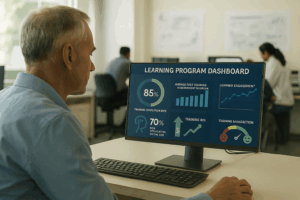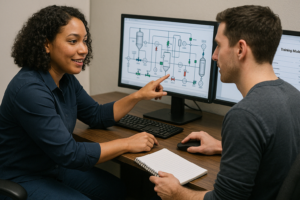
5 minute read
The Two V’s That Changed the Way I Think About Learning: Vocabulary and Visualization
David Hirsch
If you’ve ever had a student in front of you who’s trying but just not getting it, this one’s for you. After years of working on content for both new hires in industry and students in vocational programs, my foundation begins with the Two V’s—vocabulary and visualization.
Vocab First: Speak the Language of the Trade
Let’s start with vocabulary. Making sure learners know the right words and what those words actually mean in context. Terms like “heat exchanger,” “differential pressure,” or “cascade control” might feel second nature to us, but for someone just coming out of high school or transitioning from another career, it’s a whole new language. And if they don’t speak the language, they can’t think in it. Vocabulary gives learners the mental labels they need to process what they’re seeing and doing. When we teach terminology early and reinforce it often, learners start building mental shortcuts that make everything else easier to grasp.
Visualization: Help Them See What They Can’t Yet See
The second “V” is just as powerful: visualization. This is where so many learners fall short—not because they’re not smart enough, but because they can’t see how it all fits together. How can they operate and troubleshoot complex process equipment when they can’t see inside it, and they don’t yet understand it. That’s where a solid base model comes in. Whether it’s a whiteboard drawing, an animation, or a 3D model, learners need to picture what’s happening inside the equipment to understand the more complex learning that follows. Remember, at this level we don’t need to teach engineering-level detail. We just need to help them build a basic mental model—one they can add to over time.
Give Them Context—But Not Too Much
Here’s a key insight: don’t overload them with context. Because we want to share our knowledge and experience, instructors (especially those of us who come from industry) tend to explain way more than the learner can absorb early on. At this stage of learning, relevance and simplicity win. Connect the concept to what they’ll do on the job. Leave the deep-dive theory for later. This isn’t just good practice—it’s backed by research. Adult learning concepts from Cognitive Load Theory, Andragogy, Constructivist Learning Theory, and Zone of Proximal Development all tell us: meet learners where they are, and layer complexity as they’re ready for it.
Why This Works—And Why It Matters
When you give your learners both the words and a way to visualize what’s happening, they shift from just doing to actually understanding. They stop memorizing steps and start anticipating the “why” behind them. Once learners connect the terminology with the visuals, they get more engaged, ask better questions, and build confidence fast. And that opens the door to the next phases of detailed and complex training.
Takeaway for Instructors/Trainers
Teach the vocabulary early and often. Reinforce it through hands-on activities and assessments.
Help learners build a mental model. Use anything visual—cutaways, process diagrams, digital video, 3D models —to show them how the system works.
Layer in the right amount of context. Stay grounded in what’s relevant to their role and level of knowledge/experience. Keep it simple at first, and build from there.
You’ll be amazed at how much faster your learners gain traction.
Want to talk more? Contact David Hirsch.

Boosting Operator Competency: Why Practical, Data-Driven Training Delivers Real Results
5 minute read Why Practical, Data-Driven Training Delivers Real Results David Hirsch In industrial environments, operator errors don’t just result in inefficiencies, they can be

The Hidden Cost of Inconsistent Training
5 minute read The Hidden Cost of Inconsistent Training David Hirsch Why outdated materials, lack of lesson plans, and instructional gaps undermine workforce learning –

How Process Technology Education Can Prepare Students for Real-World Applications
3 minute read How Process Technology Education Can Prepare Students for Real-World Applications David Hirsch For students stepping into the world of process technology, the

The Two V’s That Changed the Way I Think About Learning
5 minute read The Two V’s That Changed the Way I Think About Learning: Vocabulary and Visualization David Hirsch If you’ve ever had a student
